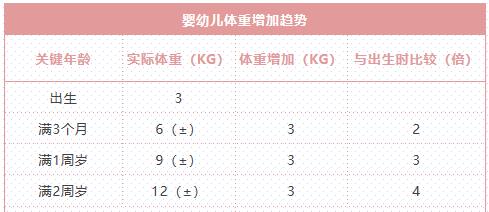If the growth is normal, parents should not easily cut off drugs or nutritional products for a long time because of unimportant things such as thin or dry stools, small food intake, and poor appetite.
Of course, there is no need to test the trace elements for blood testing, and the trace elements cannot objectively reflect the development of infants and young children.
At any time, there will definitely be half of the children below the average, so parents should not think that below the average level is a problem, that is, "not up to standard", you should supplement calcium and other trace elements.
As long as the child receives balanced nutrition and grows according to the trajectory it should be. Don't think averages are acceptable minimums.
- Weight
Weight is the comprehensive weight of the baby's organs, systems, and body fluids, and it is a sensitive indicator of the baby's growth and nutritional status.
Weight is less affected by genetics, and is more affected by factors such as nutrition and physical health. For example, weight drops rapidly during illness, and then rises quickly after improvement. For babies, weight has a lot to do with feeding.
There are significant individual differences in the weight gain of children, and the growth rate cannot be measured in "absolute growth grams", so use a growth and development curve. If the weight deviates from the growth and development curve of a normal child of the same age, it is necessary to look for the cause.

- Height
Height (body length) refers to the sum of the length of the head, spine, and lower limbs, that is, the vertical length from the top of the head to the sole of the foot.
The development of the length (height) of infants and young children is also a process of uniform growth. In addition, there are individual differences in the growth of height at different times, so the speed of the baby's growth is not compared with others, but should be compared with the baby's past with the help of the growth curve.
Compared with weight, the baby's height (length) changes are relatively stable, and problems such as acute diseases do not affect height. If the height growth is slow, it indicates that there is a problem for a long time. Generally speaking, the baby's height grows slowly, and the first thing parents suspect is that the baby lacks trace elements. In fact, this situation should be independent of trace elements and should be considered in the first place in relation to feeding.
You should pay attention to a few points: the amount, type, traits, and digestion and absorption of the baby's food, and whether there is abnormal loss (for example, allergies, congenital diseases, etc.).
- Head circumference
Head circumference refers to the maximum circumference of the head, reflecting the development of the brain and skull. After birth, the skull is not fused into one piece like an adult, but is made up of multiple pieces of bone, each with a gap between them and can be moved within a certain range.
Posterior fontanelle is small, generally physiologically closed 3 months after birth;
Cranial sutures are generally closed 6 months after birth;
The fontanelle is larger and usually closes 18-24 months after birth.
When the fontanelle is closed, it means that multiple skulls are fused into one skull.
Premature closure of the fontanelle is not conducive to brain development.
Anterior fontanelle – excessive pressure in the skull
Increased intracranial pressure may be caused by severe crying, encephalitis or meningitis;
Anterior fontanelle depression – intracranial pressure is too low
Intracranial pressure loss may be caused primarily by dehydration.
There are often parents who pay attention to the closure of their children's fontanelles and worry that the fontanelles will close prematurely.
In fact, to evaluate the baby's skull, it is not only necessary to measure the anterior fontanelle, but also to pay attention to the skull seam and head circumference. It is most important to observe the growth of the head circumference. As long as the head circumference grows steadily and normally, it will indirectly reflect the normal development of the brain, and there is no need to worry about what level.
It is not normal to have an excessive head circumference or suddenly grow too rapidly, it may be hydrocephalus or a brain tumor;
If the head circumference is too small or does not grow normally, it may be cerebral dysplasia or microcephaly.
After birth, the baby's asymmetrical head shape takes several months to gradually return to normal.
The infant's brain development must be judged by combining the measurement of the head circumference, anterior fontanelle, and cranial suture, plus the development of the brain and nervous system. Don't judge baby brain development based on one or the other, such as too small anterior fontanelle. Only a comprehensive assessment can understand the infant's brain development.